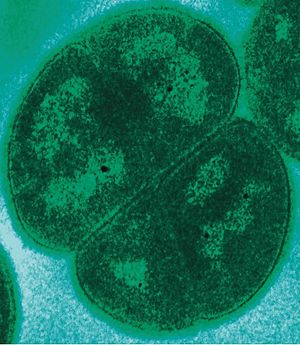Deinococcus–Thermus facts for kids
Quick facts for kids Deinococcus–Thermus |
|
|---|---|
 |
|
| Scientific classification | |
| Domain: | |
| (unranked): |
Terrabacteria
|
| Phylum: |
Deinococcus–Thermus
|
| Class: |
Deinococci
|
| Orders & Families | |
|
|
| Synonyms | |
|
|
Deinococcus–Thermus is a special group, or phylum, of bacteria. These tiny living things are known as extremophiles. This means they can survive in very harsh places. They are super tough and can handle many environmental dangers.
These bacteria have strong cell walls. Because of these walls, they look gram-positive when scientists use a special stain. But they also have a second outer layer, which is more like gram-negative bacteria. A scientist named Cavalier-Smith gave this group the nickname Hadobacteria. This name comes from Hades, the ancient Greek word for the underworld. It shows how tough and extreme these bacteria are!
Contents
What Makes Deinococcus–Thermus So Tough?
Deinococcus–Thermus bacteria are amazing survivors. They can live in conditions that would kill most other living things. This is why they are called extremophiles.
Surviving Radiation and More
One of the most famous members of this group is Deinococcus radiodurans. This bacterium is incredibly resistant to radiation. It can survive radiation levels that are thousands of times higher than what would kill a human. It can even survive strong ultraviolet light and being completely dried out.
Scientists are very interested in how these bacteria do it. They have special ways to repair their DNA very quickly. This helps them fix damage caused by radiation or other dangers.
Their Unique Cell Structure
The special structure of their cell walls helps them survive. They have a thick inner wall, like gram-positive bacteria. But they also have an outer membrane, similar to gram-negative bacteria. This double protection helps them keep harmful things out and protects their insides.
Where Do They Live?
Because they are so tough, Deinococcus–Thermus bacteria can be found in many different places. They can live in:
- Places with high radiation, like nuclear waste sites.
- Areas that get very dry.
- Environments with extreme temperatures, both hot and cold.
Scientists study these bacteria to learn more about life in extreme conditions. They also hope to use their amazing survival skills for things like cleaning up pollution or protecting other living things from radiation.
See also
- In Spanish: Deinococcus-Thermus para niños

